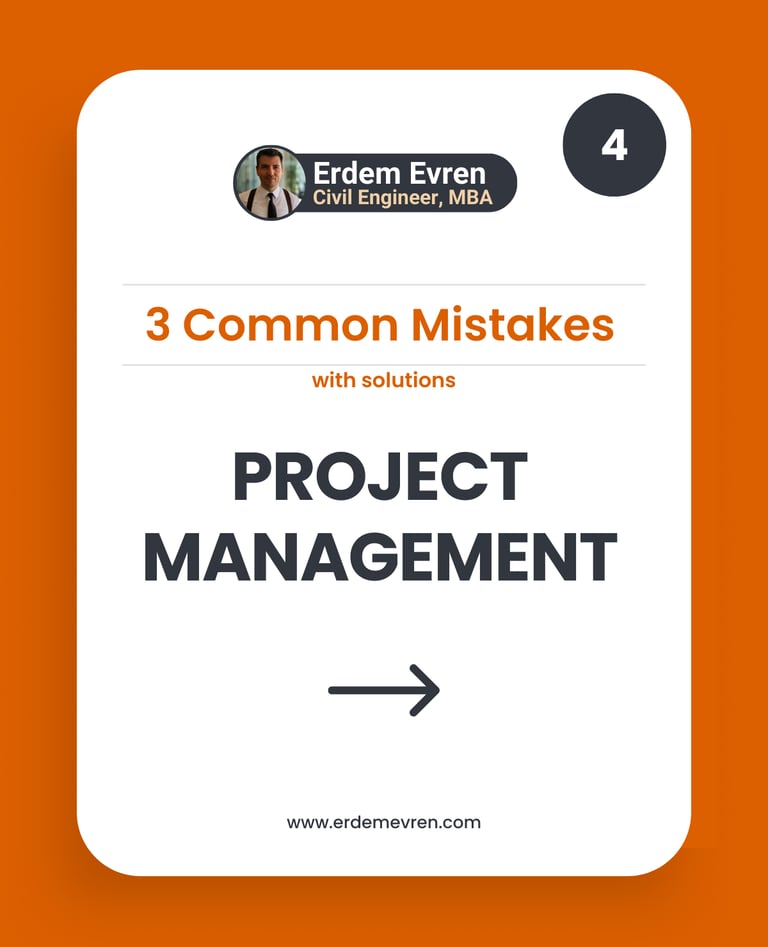Biggest Project Management Mistakes and How to Fix Them
Concise yet insightful!


𝟯 𝗖𝗼𝗺𝗺𝗼𝗻 𝗣𝗿𝗼𝗷𝗲𝗰𝘁 𝗠𝗮𝗻𝗮𝗴𝗲𝗺𝗲𝗻𝘁 𝗠𝗶𝘀𝘁𝗮𝗸𝗲𝘀 & 𝗛𝗼𝘄 𝘁𝗼 𝗔𝘃𝗼𝗶𝗱 𝗧𝗵𝗲𝗺 🌟
In project management, small mistakes can lead to significant delays and cost overruns. Here are three common mistakes and how to address them:
🟩 𝗨𝗻𝗿𝗲𝗮𝗹𝗶𝘀𝘁𝗶𝗰 𝗧𝗶𝗺𝗲𝗳𝗿𝗮𝗺𝗲𝘀
One of the biggest challenges in project management is setting achievable deadlines. Often, project managers feel pressured to deliver projects faster, leading to overly optimistic timeframes. When deadlines are too tight, it results in team stress, compromised quality, and delays.
Solution:
To avoid this, it's crucial to collaborate with your team and use historical data from similar projects to provide a more accurate timeline. Introducing time buffers for unforeseen obstacles is a practical strategy. For instance, if a task is estimated to take 5 days, add a buffer of 1-2 days to handle any unexpected challenges. This approach not only reduces pressure but also builds flexibility into the project timeline.
🟧 𝗢𝘃𝗲𝗿𝗹𝗼𝗮𝗱𝗶𝗻𝗴 𝗣𝗿𝗼𝗷𝗲𝗰𝘁𝘀 𝘄𝗶𝘁𝗵 𝗨𝗻𝗻𝗲𝗰𝗲𝘀𝘀𝗮𝗿𝘆 𝗙𝗲𝗮𝘁𝘂𝗿𝗲𝘀
It’s easy to fall into the trap of adding features that seem useful but don't directly align with the project's core objectives. Known as "feature creep," this adds complexity and increases the risk of project delays.
Solution:
Always maintain focus on the project's main goals. Prioritize features and tasks that bring the most value. By eliminating unnecessary work, you can streamline efforts, maintain clarity, and reduce complexity. A good way to manage this is by conducting regular reviews to ensure that every task aligns with the project’s key deliverables.
🟨 𝗡𝗼𝘁 𝗦𝗲𝘁𝘁𝗶𝗻𝗴 𝗣𝗲𝗿𝗳𝗼𝗿𝗺𝗮𝗻𝗰𝗲 𝗜𝗻𝗰𝗲𝗻𝘁𝗶𝘃𝗲𝘀
Teams need motivation to perform at their best. Without proper incentives, productivity can suffer, and overall project outcomes might not meet expectations. Performance incentives drive employees to focus on high-quality work and achieve better results.
Solution:
Introducing rewards for meeting key milestones, achieving targets, or completing tasks ahead of schedule can boost motivation. These incentives don’t always have to be financial; recognition, team outings, or even extra time off can work wonders. Motivated teams tend to deliver higher quality work, which ultimately leads to successful project completion.
